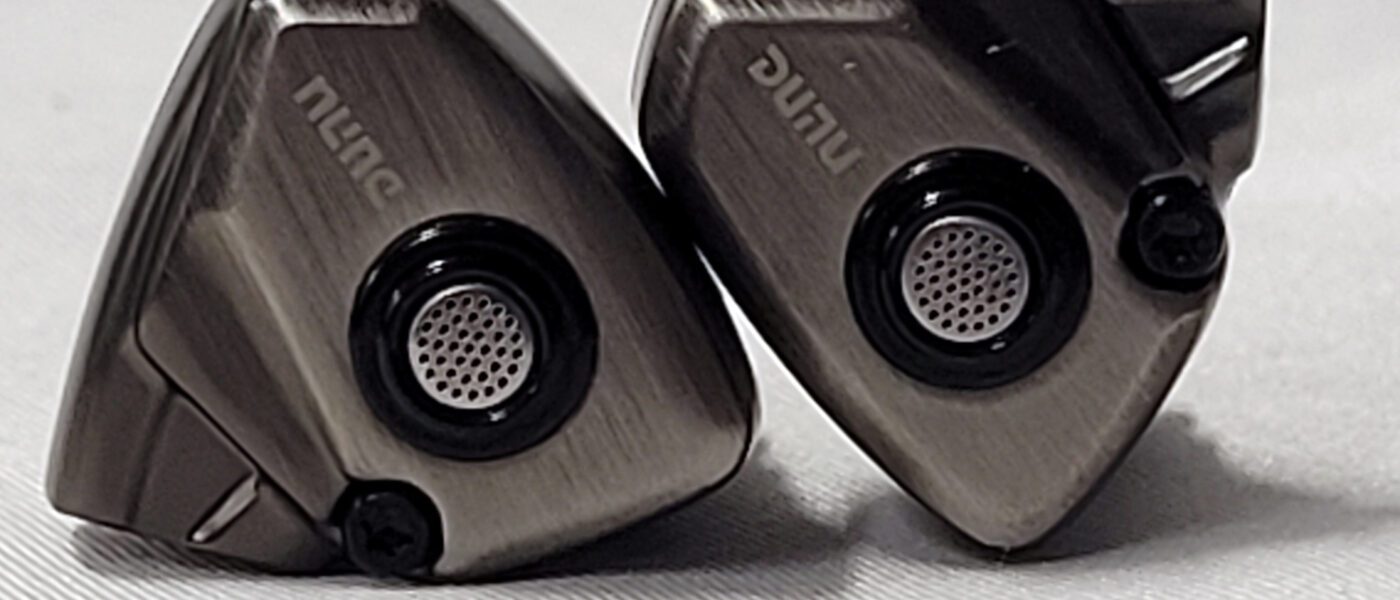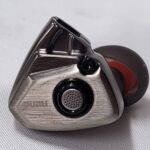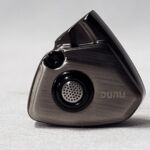Dunu TitanS
disclaimer: The Dunu TitanS was sent by Dunu for purposes of this review. I have no financial interest in Dunu, any of its distributors, or resellers. I will admit to an ongoing love affair with several of Dunu’s in-ears and I probably am a bit biased in that I have an expectation that they will perform well. For more information on the Titan S or to purchase your own, See the Dunu website.
Unboxing / Packaging:
The TitanS ships in slip-cover with the earpieces displayed on front and the specifications on the rear. The inner box is gloss black with Dunu in silver on the top and is tastefully understated. Lifting the lid reveals the blue zipper case with the earpieces, cable, and accessories all hiding either in it or under it. The kit consists of the case, earpieces, cable, 10 sets of tips in three different styles, a shirt clip, and various instruction and warranty cards. The kit is impressive, not for the sheer volume of stuff, but for the quality of the items in it as the soft case is the same model paired with the Falcon Pro and models higher up the line. It would have been easy to cut corners on this budget model, but Dunu didn’t.
Build/Fit:
Those familiar with the Titan line will take one look at the Titan S and know that something has changed. The earlier Titans all shared a very similar shell design that I call the ice cream cone shape with a small faceplate and outer shell followed by a bell to house the driver and then a nozzle to direct sound into the ear canal. The 6 was a little bit of a departure in that it blended the two sections a bit but overall it still had the same aesthetic. Those days are gone. The Titan S is a reboot of the franchise and while internals are similar, looks are not. The new design has a larger triangular shaped zinc shell with the nozzle exiting the leading point of the triangle and the bi-pin connector the top. All the edges and corners are smoothed so they sit comfortably in the ear. There is a large functional outer vent and another smaller vent just behind the nozzle on the under side of the shell. Size is fairly large so those with small ears may need to audition these before purchase. This is one place where the new design may be a step backward for some but for most with normal sized ears the Titan S is quite comfortable.
Internals:
The heart of the the Titan S is a new 11mm dynamic driver that while not part of the ECLIPSE family has a lot of trickle down technology from its bigger siblings. The driver uses a multi-layer polycondensated liquid crystal polymer diaphragm, an ultra-lite CCAW voice coil and N52 internal magnet structure. I’ve mentioned before that Kevlar is one form of liquid crystal polymer and the reason for use in diaphragms is its combination of stiffness and lack of weight. Copper clad aluminum wire CCAW is a cost saving measure as aluminum is less expensive but requires more space while copper is considerably more costly but more compact. The hybrid CCAW is a way to hit a happy mid-point between larger Aluminum windings and more expensive copper windings in the coil. The resulting driver has a nominal frequency response of 5Hz – 40kHz with an impedance of 32Ω (@ 1kHz) and a sensitivity of 110dB/mW (also at 1kHz). I found the Titan S easy to drive from dongles or phones and that additional power wasn’t needed for it to do its best work. The Titan S does scale some qualitatively, but doesn’t need a potent source to sound its best.
for the record, I did attempt to find an internals diagram and then not finding one did attempt to open the case on one to get internal photos. The screw is either captive or purely for looks and I gave up on trying to remove the face when it became obvious that doing so without damaging them was not likely. Maybe one of the gents that regularly do tear-downs will offer something up but I like mine well enough to not want them destroyed for the sake of a photo.
Cable:
Dunu cables have been among my favorites of late as their modular design is quite good and their durability is generally equally good. The cable here is a bit simpler than some as there are no modular connectors or fancy fittings involved. Starting at the southern end we have a 3.5mm jack in a 90° housing with a proper strain relief. The cable itself is a mix of single crystal copper and silver plated copper strands in a brown casing. From the jack to the splitter it is a 4 wire tight twist. Above the splitter it is a much looser two wire twist up to the earhooks and 0.78mm bi-pin connectors. The connectors have colored plated to denote left and right indexing and while standard cables will fit the Titan S, the geometry of the connector on the supplied cable is enough different than standard that aesthetics are impacted by switching cables.
Sound:
Bass:
The Titan S shares a similar low-end tuning with the Falcon Pro in that there is a mild emphasis in the mid-bass but the sub-bass tapers off gradually with some roll-off evident in the 30Hz range. This won’t please the basshead crowd, but is a more natural sound than many with elevated sub-bass. What sub-bass is present has good speed and some texture as well so doesn’t disapppoint qualitatively. The mid-bass emphasis is very mild and is heard more as a bit more presence in the mix than as a distinct emphasis as in reality the Titan S is near linear through about the 1kHz mark where it begins to deviate northward fairly quickly. For a budget in-ear, the bass quality is better than expected and quite different than most. Those looking for a big V need to look elsewhere as what is here is a well controlled near neutral presentation with good texture and moderate detail.
Mids:
Lower-mids have a very smooth transition from the mid-bass with no discernible bleed or obstruction and no big recess to be found. Lower vocals have good tone and cut through the mix well but are not quite as weighted as on the Falcon Pro. Guitar has a quick attack and a slight sustain that give it a natural tone and good clarity. Starting at about 1Khz there is a push forward that looks bigger on paper than it sounds in the ear. Strings have good energy while not getting too hot and piano has enough detail to be a fun listen. I didn’t find a tendency for the emphasis in the upper-mids/lower treble to become shouty but it is possible with extreme recordings that double down on the emphasis. Female vocals do stand slightly in front of their male counterparts but not artificially so. Mids are quite well done here and I had to remind myself these sell for $79 when critiquing as comparisons are generally to higher priced models.
Treble:
Unlike a lot of in-ears with an upper-mid push, the Titan S does not plateau that emphasis all the way through the lower-treble. Instead that upper-mid emphasis drops back rather rapidly above about the 3kHz mark and the result is a very non-fatiguing listen. Extension is good with roll-off somewhere above the limit of my hearing (14kHz roughly) and there is enough energy at the top to provide some air but sparkle is a bit limited. Snares have good rattle and cymbals aren’t over clicky but are slightly less than realistic. Overall, the treble tuning is on the safe side and while it won’t please treble enthusiasts, it won’t send the treble shy to the exits either.
Soundstage / Imaging:
Stage is good on the Titan S with moderate depth and only slightly more width by comparison. There is some height but it stops well short of fully three dimensional with the bulk of the sound seemingly coming from eye level almost directly in front of the listener. Seating the orchestra is straight forward with no major misplacements or overlaps. Instrument separation is good and about what you’d expect here with some mild compression becoming evident when tracks get overly complex. Imaging is good, but again stage size keeps it from being fully realized and honestly we shouldn’t expect miracles form this $79 offering.
Comparisons:
There is no shortage of budget single dynamics to compare against so I picked four of the most popular with price points that are close to the Titan S. Some a bit less, others a bit more, but those looking at buying the Titan S would likely consider all of these as direct competitors.
Fiio FD1 – $59.99 – We have to include Fiio in any discussion of budget models as they have been a dominant force in the market place. The FD1 shell is acrylic vs the metal shell of the Titan S so weight is a bit less on the Fiio. Both use a single dynamic with the fiio sporting a Beryllium coating vs the LCP of the Titan S. The Fiio is a little warmer and a bit more V-shaped and neither is going to please the bassheads in the group. Mids are a bit better on the Titan S as the FD1 is a bit recessed by comparison, but the note weight is slightly better on the FD1. Overall, I find the Titan S has a more natural tonality and is a more enjoyable listen.
Moondrop Aria – $79.99 – You couldn’t ask for a more dead on compare than these two. Both $79.99, both LCP, both metal shells, right down the line these two check all the same boxes. Size and weight won’t help us sort this one either so its down to sound. The Aria has a bit more low end and will please those looking for big bass hits a bit more. What they trade for that is clarity and while the Aria has more bass, the Titan S has the better textured more articulate of the two. At the top end, the Titan S is better extended again having more clarity and better instrument separation but coming across as a bit more technical when compared to the slightly smoother Aria. The treble shy will prefer Aria, those looking for a closer to neutral reference with more technical merit will chose Titan S.
T-force Yuan Li – $129.00 – So what does a fifty dollar step up get you? The Yuan Li is definitely more about fit and polish as its mirror polished shells stand in stark contrast to the industrial look of the Titan S. Internally the Yuan Li uses a 10mm dynamic with a DLC diaphragm so similar but not exactly the same as the Titan S. Sound wise, the Yuan Li has similar extension at the low end and won’t make the bass fans happy either so not a lot of separation there. Mid-bass is a little smoother and more organic with slightly better note weight on the Yuan Li in comparison to the Titan S. That observation really carries through the whole signature. The Yuan Li is a bit smoother, more relaxed, and effortless in its delivery while the Titan S is a bit leaner and not quite as smooth. Overall the Yuan Li is probably a better option when listening with poorly recorded tracks or just for fun while the Titan S is a bit more technical and closer to accurate.
TinHifi T2 Evo – $59.99 – And finally the step back in price. Most of the T2/T3/T4 line have shared a similar barrel shaped design with some form of 10mm dynamic driver in the shell so this could have just as well been any of the TinHifi mainstays. They also share enough in signature that likely would be interchangeable or nearly so in that respect too. The EVO uses a DLC diaphragm so a slight departure there, but other-wise specs are nearly identical. The barrel shape shell may fit smaller ears better than the Titan S but loses some style points in the process. Sound wise the two have a similar low end but mids favor the Titan S as does the treble where the T2 Evo can be too bright for some. The one place the T2 Evo is a clear winner is stage. When AB testing these two it is like going from your living room to a High School auditorium and those looking for a large stage will prefer the T2 Evo. The Titan S is a better balanced sounding in-ear than the more V shaped and bright T2 Evo though so even with its better stage, the T2 Evo falls to the Titan S.
Thoughts / Conclusion:
The sub one hundred dollar market is one of the hottest and most contested markets in earphones right now with some really brilliant products coming out. A few years ago any of the models I compared would have been a massive improvement over what was available in this price class. It’s a good time to be an audio enthusiast as prices continue to drop and quality continues to go up. That having been said when Dunu told me about the Titan S, I had my reservations. Don’t get me wrong, I like Dunu and generally think they do a good job building a quality product and aggressively pricing it. But this was something different. We want to take on the Aria on its own turf, same price, same driver type, same shell materials and we think we can beat it. The Moondrop series has been hugely popular for years and with the Aria still being on many “recommended” lists, that’s a bit like announcing your intention to beat Floyd Mayweather before you start taking boxing lessons. I’ve been a Dunu fan for years, but I was not at all sure I wouldn’t have to write a review that said “Close, but no”. I shouldn’t have doubted Dunu though as the Titan S does indeed knock the Aria out of that top spot for me and become my recommended in-ear at its price point. For a near neutral, very technical proficient in-ear that doesn’t fatigue during longer listening sessions, the Titan-S is the one to beat.
-
Bass - 8/108/10
-
Mids - 8/108/10
-
Treble - 7.5/107.5/10
-
Soundstage - 7/107/10
-
Imaging - 7.5/107.5/10
Summary
Pros: good build, near neutral signature, polite treble while still well extended
Cons: won’t please bassheads, somewhat lean





















Por favor, sería posible hacer una revisión de los Shozys V33 y los Djembe, ambos con un solo DD y en un rango de precios similar? Podría ser muy interesante. Gracias.
Please, would it be possible to do a review of the Shozys V33 and the Djembe, both with a single DD and in a similar price range? It could be very interesting. Thanks.
ordered both.